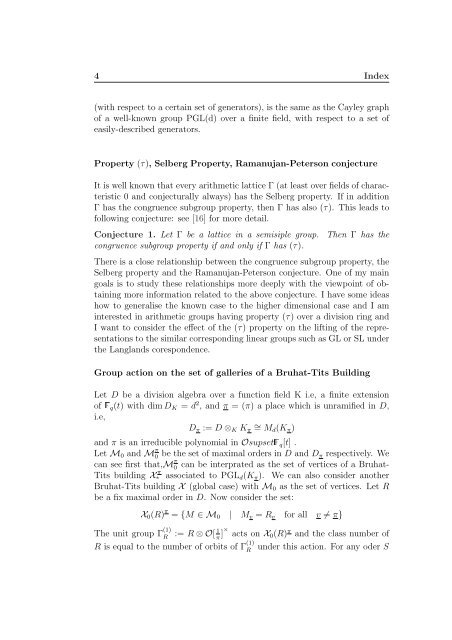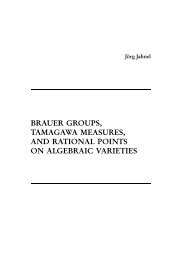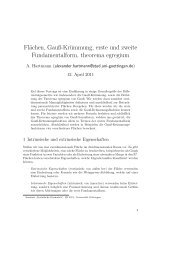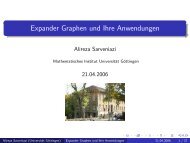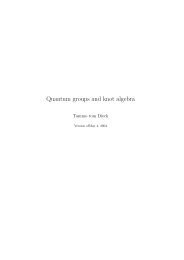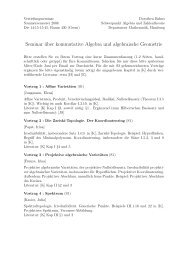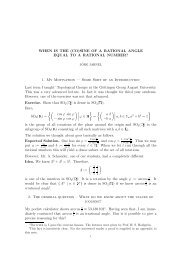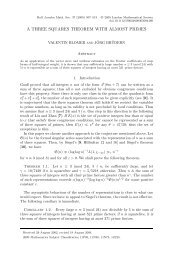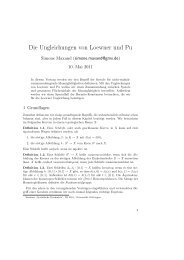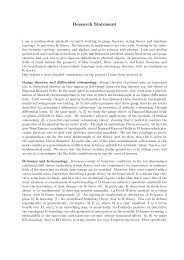Teaching Statement and Statement of Research Plans - GWDG
Teaching Statement and Statement of Research Plans - GWDG
Teaching Statement and Statement of Research Plans - GWDG
Create successful ePaper yourself
Turn your PDF publications into a flip-book with our unique Google optimized e-Paper software.
4 Index<br />
(with respect to a certain set <strong>of</strong> generators), is the same as the Cayley graph<br />
<strong>of</strong> a well-known group PGL(d) over a finite field, with respect to a set <strong>of</strong><br />
easily-described generators.<br />
Property (τ), Selberg Property, Ramanujan-Peterson conjecture<br />
It is well known that every arithmetic lattice Γ (at least over fields <strong>of</strong> characteristic<br />
0 <strong>and</strong> conjecturally always) has the Selberg property. If in addition<br />
Γ has the congruence subgroup property, then Γ has also (τ). This leads to<br />
following conjecture: see [16] for more detail.<br />
Conjecture 1. Let Γ be a lattice in a semisiple group.<br />
congruence subgroup property if <strong>and</strong> only if Γ has (τ).<br />
Then Γ has the<br />
There is a close relationship between the congruence subgroup property, the<br />
Selberg property <strong>and</strong> the Ramanujan-Peterson conjecture. One <strong>of</strong> my main<br />
goals is to study these relationships more deeply with the viewpoint <strong>of</strong> obtaining<br />
more information related to the above conjecture. I have some ideas<br />
how to generalise the known case to the higher dimensional case <strong>and</strong> I am<br />
interested in arithmetic groups having property (τ) over a division ring <strong>and</strong><br />
I want to consider the effect <strong>of</strong> the (τ) property on the lifting <strong>of</strong> the representations<br />
to the similar corresponding linear groups such as GL or SL under<br />
the Langl<strong>and</strong>s corespondence.<br />
Group action on the set <strong>of</strong> galleries <strong>of</strong> a Bruhat-Tits Building<br />
Let D be a division algebra over a function field K i.e, a finite extension<br />
<strong>of</strong> F q (t) with dim D K = d 2 , <strong>and</strong> π = (π) a place which is unramified in D,<br />
i.e,<br />
D π := D ⊗ K K π<br />
∼ = Md (K π )<br />
<strong>and</strong> π is an irreducible polynomial in OsupsetF q [t] .<br />
Let M 0 <strong>and</strong> M π 0 be the set <strong>of</strong> maximal orders in D <strong>and</strong> D π respectively. We<br />
can see first that,M π 0 can be interprated as the set <strong>of</strong> vertices <strong>of</strong> a Bruhat-<br />
Tits building X π ∗ associated to PGL d (K π ). We can also consider another<br />
Bruhat-Tits building X (global case) with M 0 as the set <strong>of</strong> vertices. Let R<br />
be a fix maximal order in D. Now consider the set:<br />
The unit group Γ (1)<br />
R<br />
X 0 (R) π = {M ∈ M 0 | M v = R v for all v ≠ π}<br />
R is equal to the number <strong>of</strong> orbits <strong>of</strong> Γ (1)<br />
R<br />
:= R ⊗ O[ 1<br />
π ]× acts on X 0 (R) π <strong>and</strong> the class number <strong>of</strong><br />
under this action. For any oder S


